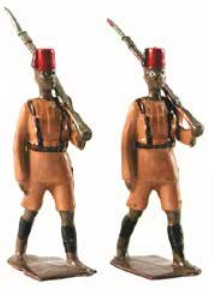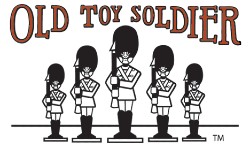This article presents an array of questions (with answers provided on pages 60-61) that should be fun for collectors of Britains to ponder. For more photographs, and to research the answers to the questions posed, see my hard-cover, all-color editions of Soldiers of Greater Britain
(1893-1924), Armies of the World (1925-1941) and Regiments of All Nations (1946-1966). Note that this article only deals with regularly catalogued sets, not Paris Office, noncatalogued or second-grade production.
Which Britains set featured turquoise-colored uniforms? Was it A. the Uruguayan Infantry of Set #222, B. the Canadian Governor-General’s Horse Guards of Set #1631, C. the Spanish Cavalry of Set #218, or D. Hodson’s Horse of Set #46?
The Spanish Cavalry of Set #218 wore resplendent turquoise-colored uniforms.
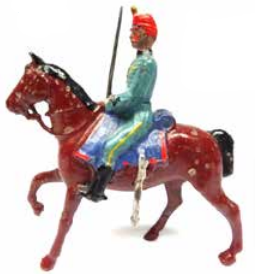
Which sets had either an officer or a piper added postwar to boost their appeal?
The sets that had either an officer or a piper added postwar consisted of Sets #11 Black Watch (a piper replaced three charging men), #142 (a mounted officer on a cantering horse was substituted for two of the charging Zouaves), #143 (a running Matelot officer was inserted during 1948-1949), #169 (a marching Bersagliere officer was switched for one man), #212 (a piper with a glengarry cap replaced three marching Royal Scots Lowlanders from the prewar set), and #2062 (a mounted Seaforth officer was added to what had been prewar Set #88).
Which sets featured Pioneers marching with axes?
Sets having pioneers marching with axes were included as Welsh Fusiliers in prewar Display Box #73, Set #82 (Scots Guards Color and Pioneers), Coldstream Guards in Display Box #93, and Scots Guards in the gigantic Set #130. Very early versions of Sets #64 (7th Bengal Infantry), #67 (1st Madras Pioneers), #68 (2nd Bombay Grenadiers), and #76 (Middlesex Regiment), briefly included a pioneer. It is also worth mentioning that Set #2067 (the Sovereign’s Escort of the Household Cavalry) had two mounted farriers with axes, and Set #2182 offered the Fort Henry Guard pioneer standing with an axe.
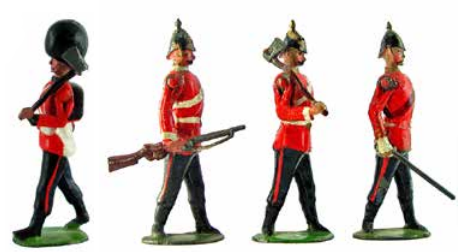
Britains issued charging fixed-arm figures that were dramatic and stayed in the catalog a long time. What were the charging first-grade sets—not counting the moveable arm figures provided in Sets #147 Zulu Warriors and #1613 British Infantry with steel helmets and gas masks?
The sets with fixed-arm charging figures were Sets #11 Black Watch Highlanders, #15 Argyll & Sutherland Highlanders, #88 (later became #2062) Seaforth Highlanders, #134 Japanese Infantry, #142 French Zouaves, #173 Servian Infantry, #191 French Turcos, and #2095 French Foreign Legion in action.
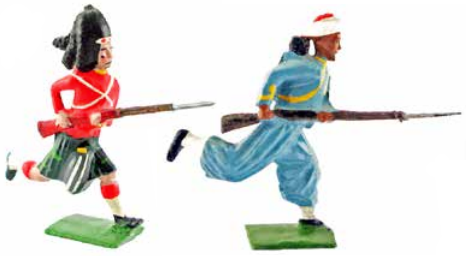
Britains offered two mounted and six infantry sets with troops wearing Winter Dress. Can you name them?
The mounted sets in Winter Dress were Set #400 Life Guards in cloaks and #1343 Royal Horse Guards in cloaks; the infantry sets wearing Winter Dress were #214 Royal Canadian Mounted Police marching at the slope with fixed bayonets, #312 Grenadier Guards in greatcoats, #429 Scots Guards in greatcoats, #2009 Belgian Grenadiers marching in greatcoats, #2017 and #2037 Ski Troopers, and #2027 Soviet Guards in greatcoats. Also, there were Sets #226 and #232 West Point Cadets in Winter Dress and #2014 U.S. Marine Corps Band in Winter Dress. (The American sets in Summer Dress, #299 and #2112, had white trousers made of a lighter material.) The officer for Set #2009, Belgian Grenadiers, wore a greatcoat, but the men used the French Foreign Legion casting with a British Fusilier head.
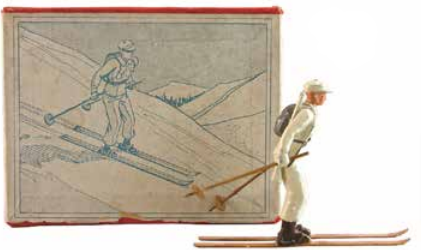
Three of Britains sets contained British Cavalry armed with slung lances. Two were only sold prewar, while the third one only adopted slung lances postwar in place of their prewar weaponry. Can you name these sets?
Three Britains mounted sets were armed with slung lances. Two were only sold prewar, Set #127 7th Dragoon Guards and Set #128 12th Lancers, while Set #24 9th Lancers, switched to slung lances postwar from holding their lances at the carry prewar.
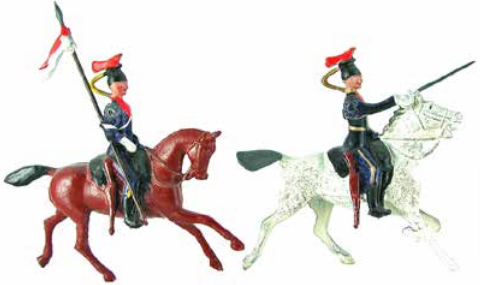
Which dismounted Britains cavalry sets were standing at attention with drawn swords?
Dismounted figures standing at attention with drawn swords appeared in Sets #2029 Life Guards Sentries, #2087 5th Royal Inniskilling Dragoon Guards, and #2119 Royal Scots Greys in a halfbox. There was also a dismounted officer holding a drawn sword in Set #182 11th Hussars, but the troopers he commanded were empty-handed. There were also dismounted cavalry with drawn swords provided as a Royal Horse Guard in Picture Pack #1340-B and a 1st Dragoon Guard in Picture Pack #1343-B.
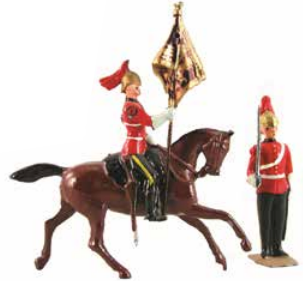
Britains had six marching sets in tropical dress wearing shorts. Name these military sets, plus the civilian sets that wore shorts?
The military sets wearing shorts included Sets #225 King’s African Rifles, #1293 Durban Light Infantry, #1294 British Infantry in Tropical Dress, #1900 the Regiment Louw Wepener, #1902 Union of South Africa Defence Force, as well as one of the Naval officers in Set1911 who wore shorts. The civilian sets were the Boy Scouts of Set #161-163, as well as the unnumbered sets of Soccer Football players and referees.
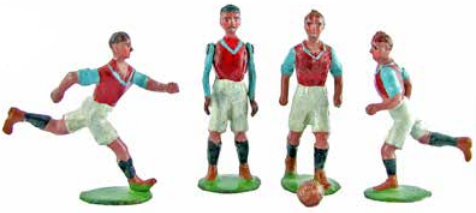
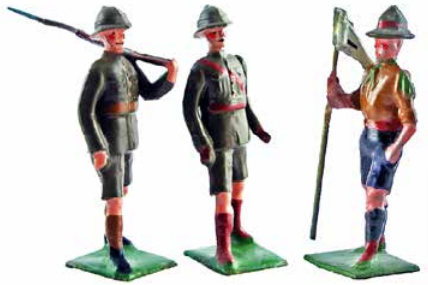
Which Britains sets were dressed in grey uniforms?
Other than the Confederate sets representing the American Civil War (Sets #2055, #2057, and #2060), Britains produced Set #117 Egyptian Infantry, #174 Montenegrin Infantry, #192 French Poilus marching with Adrian steel helmets (changed to khaki in the late 1930s), Sets #226 and #299 West Point Cadets in Winter and Summer Dress, #312 Grenadier Guards in greatcoats, #429 Scots Guards in greatcoats, the prewar version of Set #432 German Infantry, and #2027 Soviet Guards in greatcoats. Sets #139 French Chasseurs, #141 French Infanterie de Ligne (up until the 1930s), #175 Austrian Lancers, and #176 Austrian Dragoons all had grey tunics, but with red breeches.
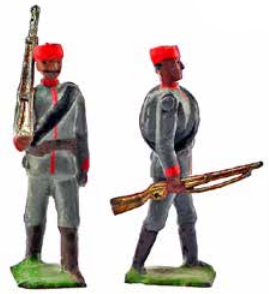
A fez is a cone-shaped felt cap, usually with a tassel on one side. Britains featured the fez as the headgear for seven of its sets. Can you identify them?
The sets that wore the fez consisted of Sets 48, Egyptian Camel Corps, #71 Turkish Cavalry, #115 Egyptian Cavalry, #116 Sudanese Infantry, #117 Egyptian Infantry, #167 Turkish Infantry, and #225 King’s African Rifles.
